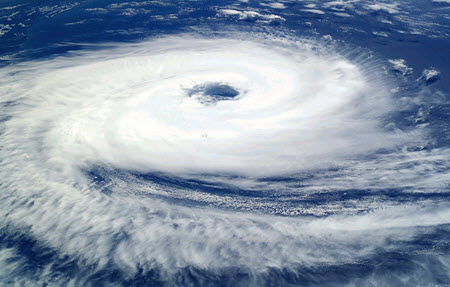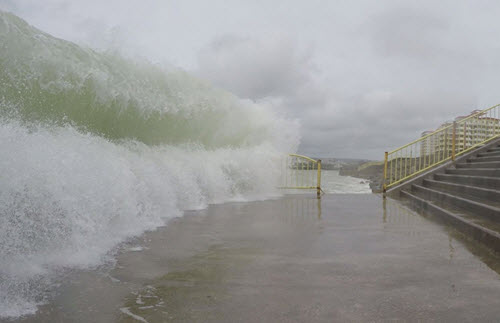Contents
A typhoon is a mature tropical cyclone that develops in the Northwestern Pacific Basin, between 180° and 100°E in the Northern Hemisphere. Nearly one-third of all the annual tropical cyclones in the world develops in this region, and this part of the world also has a tendency to get the most intense cyclones.
The Philippines is often the unlucky country to receive the brunt of the force when a typhoon makes landfall, with Japan, China and Taiwan also receiving a considerable amount of typhoon winds.
Most typhoons follow one of these three paths:
- The straight track: the typhoon will follow a general westward path and affect the Philippines, southern China, Taiwan and Vietnam.
- The parabolic re-curving track: The typhoon will re-curve and affect eastern Philippines, eastern China, Taiwan, the Korean peninsula, Japan, and Russia’s Far East.
- The northward track: The typhoon will go north, only affecting small islands.
When is the typhoon season?
Tropical cyclones form throughout the year, so there is not official typhoon season. With that said, a majority of storms in this region form between June and November, and the risk of typhoon development is much lower between December and May.
Typhoons formation
Just like other tropical cyclones, the six most important things for typhoon formation is:
 The sea surface temperature must be high enough. In most situations, this means an ocean temperature of 26.5 °C (circa 80 °F) spanning through a depth of at least 50 metres (160 ft). Without this warmth, the warm core that fuels tropical systems will not be maintained.
The sea surface temperature must be high enough. In most situations, this means an ocean temperature of 26.5 °C (circa 80 °F) spanning through a depth of at least 50 metres (160 ft). Without this warmth, the warm core that fuels tropical systems will not be maintained.- The humidity in the lower to middle levels of the troposphere must be high enough
- There must be sufficient atmospheric instability
- There must be enough Coriolis force to develop a low pressure center
- There must be a pre-existing low level focus or disturbance
- The vertical wind shear between the ocean surface and the tropopause must be low, typically less than 10 m/s (20 kn or 33 ft/s).
Even if all these conditions are present, that doesn’t guarantee that a typhoon will form.
Roughly 85-90% of typhoons form within the monsoon.
Records
Wind speed
The highest reliably-estimated sustained typhoon wind speed is 314 km/h (195 mph). This was for the Typhoon Haiyan shortly before it made landfall in the Philippines on 8 November, 2013.
Pressure
The lowest reliably measured typhoon pressure was 870 hectopascals (26 inHg). This occurred with the Typhoon Tip in 1979.
Rain
Typhoon Morakot brought record-breaking heavy rain to Taiwan, after landing there at midnight on 8 August, 2009. Pingtun County received 2,327 mm (91.6 in) of rain.
Deadliness
It is difficult to reliably estimate the deadliness of typhoons that took place long ago, but the deadliest typhoon since the start of the 20th century was Typhoon Nina. In 1975, Typhoon Nina killed nearly 100,000 people in China as flooding caused 12 reservoirs to fail.
What’s the difference between a typhoon and hurricane?
 Different names are used for these violent storms depending on where they occur.
Different names are used for these violent storms depending on where they occur.
- A typhoon is a severe tropical cyclone that occurs in the northwestern Pacific Ocean region.
- A hurricane is a severe tropical cyclone that occurs in the Atlantic Ocean region.
- Elsewhere, such as in in the south Pacific Ocean or Indian Ocean, a is a severe tropical cyclone is simply called severe tropical cyclone.
Sometimes storms are re-named as they move into a new geographical region. In 1994, Hurricane John did for instance end up being Typhoon John.
Etymology
The word typhoon is derived from words used locally for these storms, especially tai fung from the Chinese language and ṭūfān from Urdu. Many different spelling variants have been used in English texts, such as touffon, tufan, tuffon, tiffoon, tay-fun and ty-foong.
How are typhoons rated?
The RSMC Tokyo’s Tropical Cyclone Intensity Scale is widely used to rate typhoons based on their intensity.
| Category | Sustained winds |
| Violent Typhoon | ≥105 knots ≥194 km/h |
| Very Strong Typhoon | 85–104 knots 157–193 km/h |
| Typhoon | 64–84 knots 118–156 km/h |
| Severe Tropical Storm | 48–63 knots 89–117 km/h |
| Tropical Storm | 34–47 knots 62–88 km/h |
| Tropical Depression | ≤33 knots ≤61 km/h |
